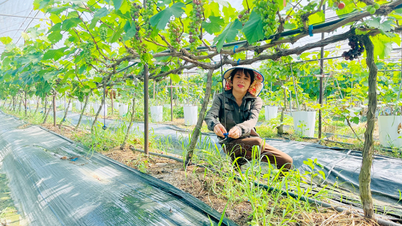In the second year of implementing a policy limiting the number of international students enrolled, Canada aims to issue only 437,000 study permits, down 10% from 2024 and more than half from 2023.

Graduate of the University of British Columbia, one of Canada's top schools
PHOTO: UNIVERSITY OF BRITISH COLUMBIA
The regulation, which will officially take effect at the end of January 2025, aims to continue to maintain the integrity of internationaleducation programs and help reduce pressure on housing, health care and other services, according to a recent announcement from Immigration, Refugees and Citizenship Canada (IRCC). This measure has reduced the number of international students coming to Canada by about 40% in the first year of implementation (2024), IRCC emphasized.
How many international students does each province accept?
In 2025, IRCC expects to issue a total of 437,000 study permits. This is a necessary document for international students to study and work in Canada in addition to their visa. Of these, 73,282 study permits will be issued for graduate studies and 72,200 for high school, while 242,994 will be for undergraduate and other programs. Priority and vulnerable groups or those who need to apply for a study permit extension account for 48,524.
To apply for a study permit, applicants must submit a Provincial or Territorial Letter of Attestation (PAL/TAL). IRCC has announced that in 2025, postgraduate students (masters and doctoral) will be required to submit a PAL/TAL, instead of just undergraduate students. However, some groups will continue to be exempt from submitting a PAL/TAL in 2025, including high school students; priority and vulnerable applicants; or those applying for a study permit extension.
The good news is that exchange students are now also exempt from PAL or TAL, as the Canadian government wants to ensure that domestic students “can continue to benefit from bilateral study arrangements,” the document states. Conversely, the inclusion of postgraduate students in the PAL/TAL category is “a precautionary measure” to ensure that the number of international students in this group is well managed, according to IRCC.
In the official announcement, IRCC also stated the maximum number of study permits each province or territory is allowed to issue. Of which, Ontario is allocated the most quota with 116,740 study permits, followed by Quebec (72,997) and British Columbia (53,589). In contrast, the regions with the fewest study permits are Yukon (339) and Northwest Territories, Nunavut (both 220).

School representatives advise Vietnamese parents and students at a Canadian study abroad seminar held in 2024 in Ho Chi Minh City.
In total, Canadian provinces and territories will issue 316,276 study permits to international students who are required to submit PAL/TAL. Meanwhile, the remaining 120,724 permits will be for those who are exempt from submitting PAL/TAL. In each province, the number of study permits issued for each type is also different. For example, in Ontario, public schools receive 96% of study permit applications, the remaining 4% are for language schools, private universities, etc.
Outstanding policies taking effect in 2025
Earlier in mid-January, IRCC also began tightening its rules for working with family members of international students. Specifically, the spouses of master’s students are now only allowed to work if their accompanying family member’s program of study lasts at least 16 months. In addition, the spouses of doctoral students and those studying certain “professional and qualified” programs will also be allowed to work.
In early January, IRCC expanded opportunities for international students to stay and work, adding nearly 40 training programs and a new field to its long-term shortage list. In November 2024, the agency also increased the number of hours international students are allowed to work off-campus during school hours, up to 24 hours per week instead of just 20 hours as before.
In 2024, a number of other regulations issued by the Canadian government will also continue to take effect in 2025, such as doubling the financial proof requirement to CAD 20,635 (VND 359 million) for international students; requiring international students who want to transfer schools while studying in Canada to apply for a new study permit, instead of just updating related information on the IRCC system.
According to a report from IRCC, Canada attracted more than 1 million international students to study in 2023. IRCC statistics also show that the total number of Vietnamese studying in Canada has been on a continuous downward trend, from 21,480 in 2019 to only 16,140 in 2022. By 2023, the number of Vietnamese students in Canada increased slightly, to 17,175, ranking 8th in number. For undergraduate degrees, the annual cost is about 36,000 CAD (626 million VND).
Source: https://thanhnien.vn/nam-2025-canada-tiep-tuc-cat-giam-so-du-hoc-sinh-toi-nuoc-nay-vi-sao-185250204150850658.htm


![[Photo] General Secretary To Lam receives First Deputy Secretary General of the African National Congress (ANC) of South Africa](https://vphoto.vietnam.vn/thumb/1200x675/vietnam/resource/IMAGE/2025/5/20/bb2999907e1245d5b4c7310a890d8201)


































![[Photo] Vietnamese shipbuilding with the aspiration to reach out to the ocean](https://vphoto.vietnam.vn/thumb/1200x675/vietnam/resource/IMAGE/2025/5/20/24ecf0ba837b4c2a8b73853b45e40aa7)
![[Photo] Award ceremony for works on studying and following President Ho Chi Minh](https://vphoto.vietnam.vn/thumb/1200x675/vietnam/resource/IMAGE/2025/5/20/a08ce9374fa544c292cca22d4424e6c0)































































Comment (0)